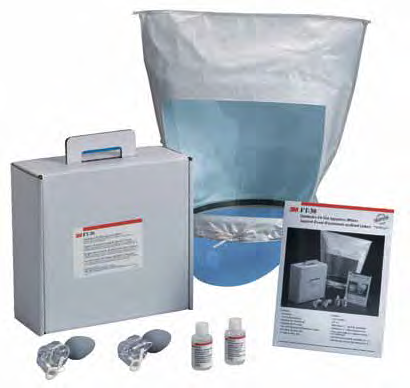Update: January 2022
27.1 Introduction
Respirators are masks designed to protect the wearer from inhaling bacilli.
Staff must wear a respirator when the risk of TB transmission is high (Chapter 14).
Attendants and visitors must wear a respirator when entering a ward or room of infectious TB patients.
Recommended respirators include:
- The CE-certified filtering facepiece EN 149 FFP2, filtering efficiency 94% if challenged with 0.4 μm particles;
or - The United States Centre for Disease Control and Prevention/National Institute for Occupational Safety and Health (NIOSH) certified N95, filtering efficiency > 95% if challenged with 0.3 µm particles.
27.2 Instructions for use
Respirators are for personal use. The same respirator cannot be shared between staff members or between attendants and visitors.
The respirator should be put on before entering the room and removed after exiting the room.
Respirators must be worn covering the nose, mouth and chin and provide a tight seal around the edge. Every time that a respirator is put on, a seal check has to be performed:
- Fully open the respirator and slightly bend the nose wire to form a curve.
- Separate the two elastic straps and position the respirator under the chin.
- Stretch the two elastic straps over the head, place the first strap at neck-height and the second strap across the top of the head.
- Model the nose wire around the bridge of the nose and secure the edges until you achieve a perfect
- Check for leaks by covering the respirator with both hands and forcefully inhaling and exhaling several times. The respirator should collapse when inhaling and expand when exhaling and no air leak between the face and the respirator should be. Otherwise, elastic straps should be readjusted and/or the respirator repositioned until is sealed properly.
Different factors may not allow proper sealing of respirators to the face: respirator size and/or model; respirator wearer’s facial features, including beard and facial hair; headscarves, etc.
There is limited evidence on the acceptable length of time a respirator can be worn with maintained efficiency. The filter materials remain functional for weeks or months, but with frequent wearing the respirator will become less adjusted.
An extensively used respirator should be discarded after 7 days. However, if for example, it is only used a few hours 2 to 3 times a week, it can be reused for several weeks
[1]
Citation
1.
Roland Diel, Albert Nienhaus, Peter Witte, Renate Ziegler. Protection of healthcare workers against transmission of Mycobacterium tuberculosis in hospitals: a review of the evidence. ERJ Open Research 2020 6: 00317-2019.
https://doi.org/10.1183/23120541.00317-2019
. During this period, staff can reuse their respirator provided it is not wet or damaged and its straps are not loosened. Each staff member should keep their respirator in the pocket of their personal gown without creasing it. If the filter material is damaged or the mask has loose straps, the respirator should be discarded immediately.
Note: TB bacillus is trapped in the filter of a mask and will not be released with shaking or other physical movements of the mask.
27.3 Storage
Store in a dry, well ventilated place. Respirators should not be crushed during storage.
27.4 Disposal
Respirators are disposed of as "soft waste" and do not need to be disinfected before being discarded.
27.5 Fit testing
All staff members who could be exposed to M. tuberculosis should before being required to wear a respirator perform a "fit testing" to determine if the respirators being used fit them properly.
At least two models of respirators should be available. If a worker cannot be fitted with one model, the other one should be used.
Testing is performed using a fit testing kit. The kit contains all the supplies and instructions needed to perform the test.
Fist testing kit
- 1.Roland Diel, Albert Nienhaus, Peter Witte, Renate Ziegler. Protection of healthcare workers against transmission of Mycobacterium tuberculosis in hospitals: a review of the evidence. ERJ Open Research 2020 6: 00317-2019.
https://doi.org/10.1183/23120541.00317-2019
